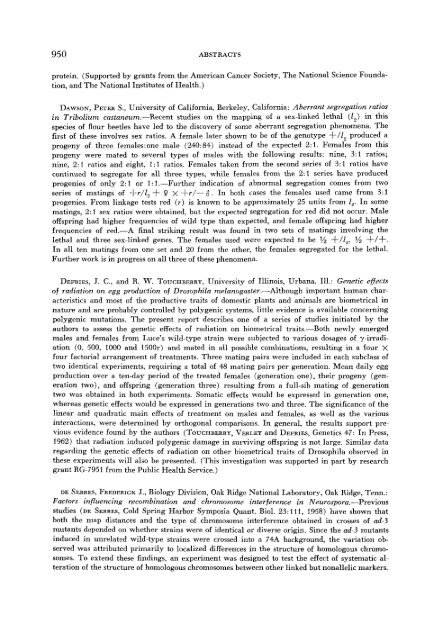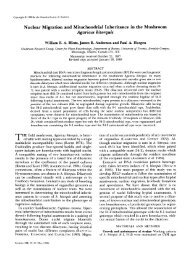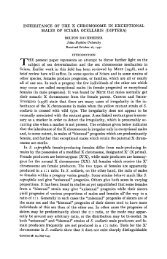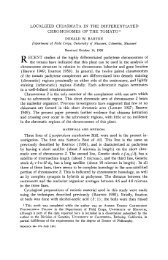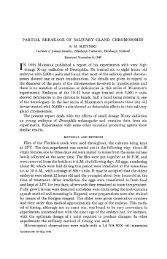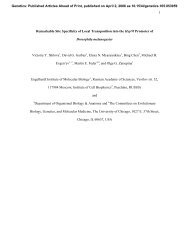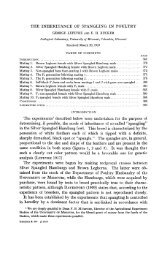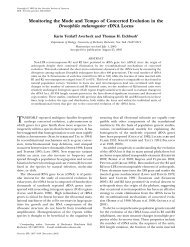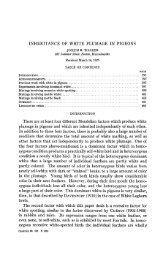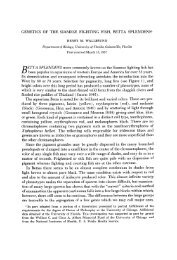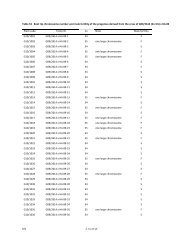abstracts of papers presented at the 1962 meetings - Genetics
abstracts of papers presented at the 1962 meetings - Genetics
abstracts of papers presented at the 1962 meetings - Genetics
You also want an ePaper? Increase the reach of your titles
YUMPU automatically turns print PDFs into web optimized ePapers that Google loves.
950 ABSTRACTS<br />
protein. (Supported by grants from <strong>the</strong> American Cancer Society, The N<strong>at</strong>ional Science Founda-<br />
tion, and The N<strong>at</strong>ional Institutes <strong>of</strong> Health.)<br />
DAWSON, PETER S., University <strong>of</strong> California, Berkeley, California: Aberrant segreg<strong>at</strong>ion r<strong>at</strong>ios<br />
in Tribolium castaneum.-Recent studies on <strong>the</strong> mapping <strong>of</strong> a sex-linked lethal (I,) in this<br />
species <strong>of</strong> flour beetles have led to <strong>the</strong> discovery <strong>of</strong> some aberrant segreg<strong>at</strong>ion phenomena. The<br />
first <strong>of</strong> <strong>the</strong>se involves sex r<strong>at</strong>ios. A female l<strong>at</strong>er shown to be <strong>of</strong> <strong>the</strong> genotype +/l, produced a<br />
progeny <strong>of</strong> three fema1es:one male (240:84) instead <strong>of</strong> <strong>the</strong> expected 2:l. Females from this<br />
progeny were m<strong>at</strong>ed to several types <strong>of</strong> males with <strong>the</strong> following results: nine, 3:l r<strong>at</strong>ios;<br />
nine, 2:l r<strong>at</strong>ios and eight, 1:l r<strong>at</strong>ios. Females taken from <strong>the</strong> second series <strong>of</strong> 3:l r<strong>at</strong>ios have<br />
continued to segreg<strong>at</strong>e for all three types, while females from <strong>the</strong> 2:l series have produced<br />
progenies <strong>of</strong> only 2:l or 1:l.-Fur<strong>the</strong>r indic<strong>at</strong>ion <strong>of</strong> abnormal segreg<strong>at</strong>ion comes from two<br />
series <strong>of</strong> m<strong>at</strong>ings <strong>of</strong> +r/Z2 + 9 x +r/- 3. In both cases <strong>the</strong> females used came from 3:l<br />
progenies. From linkage tests red (r) is known to be approxim<strong>at</strong>ely 25 units from I,. In some<br />
m<strong>at</strong>ings, 2: 1 sex r<strong>at</strong>ios were obtained, but <strong>the</strong> expected segreg<strong>at</strong>ion for red did not occur. Male<br />
<strong>of</strong>fspring had higher frequencies <strong>of</strong> wild type than expected, and female <strong>of</strong>f spring had higher<br />
frequencies <strong>of</strong> red.-A final striking result was found in two sets <strong>of</strong> m<strong>at</strong>ings involving <strong>the</strong><br />
lethal and three sex-linked genes. The females used were expected to be i/z +/12, % +/f.<br />
In all ten m<strong>at</strong>ings from one set and 20 from <strong>the</strong> o<strong>the</strong>r, <strong>the</strong> females segreg<strong>at</strong>ed for <strong>the</strong> lethal.<br />
Fur<strong>the</strong>r work is in progress on all three <strong>of</strong> <strong>the</strong>se phenomena.<br />
DEFRIES, J. C., and R. W. TOUCHBERRY, University <strong>of</strong> Illinois, Urbana, Ill.: Genetic effects<br />
<strong>of</strong> radi<strong>at</strong>ion on egg production <strong>of</strong> Drosophila meZanogaster.-Although important human characteristics<br />
and most <strong>of</strong> <strong>the</strong> productive traits <strong>of</strong> domestic plants and animals are biometrical in<br />
n<strong>at</strong>ure and are probably controlled by polygenic systems, little evidence is available concerning<br />
polygenic mut<strong>at</strong>ions. The present report describes one <strong>of</strong> a series <strong>of</strong> studies initi<strong>at</strong>ed by <strong>the</strong><br />
authors to assess <strong>the</strong> genetic effects <strong>of</strong> radi<strong>at</strong>ion on biometrical traits.-Both newly emerged<br />
males and females from Luce’s wild-type strain were subjected to various dosages <strong>of</strong> y-irradi<strong>at</strong>ion<br />
(0, 500, 1000 and 1500r) and m<strong>at</strong>ed in all passible combin<strong>at</strong>ions, resulting in a four X<br />
four factorial arrangement <strong>of</strong> tre<strong>at</strong>ments. Three m<strong>at</strong>ing pairs were included in each subclass <strong>of</strong><br />
two identical experiments, requiring a total <strong>of</strong> 48 m<strong>at</strong>ing pairs per gener<strong>at</strong>ion. Mean daily egg<br />
production over a ten-day period <strong>of</strong> <strong>the</strong> tre<strong>at</strong>ed females (gener<strong>at</strong>ion one), <strong>the</strong>ir progeny (gener<strong>at</strong>ion<br />
two), and <strong>of</strong>fspring (gener<strong>at</strong>ion three) resulting from a full-sib m<strong>at</strong>ing <strong>of</strong> gener<strong>at</strong>ion<br />
two was obtained in both experiments. Som<strong>at</strong>ic effects would be expressed in gener<strong>at</strong>ion one,<br />
whereas genetic effects would be expressed in gener<strong>at</strong>ions two and three. The significance <strong>of</strong> <strong>the</strong><br />
linear and quadr<strong>at</strong>ic main effects <strong>of</strong> tre<strong>at</strong>ment on males and females, as well as <strong>the</strong> various<br />
interactions, were determined by orthogonal comparisons. In general, <strong>the</strong> results support previous<br />
evidence found by <strong>the</strong> authors (TOUCHBERRY, VERLEY and DEFRIES, <strong>Genetics</strong> 47: In Press,<br />
<strong>1962</strong>) th<strong>at</strong> radi<strong>at</strong>ion induced polygenic damage in surviving <strong>of</strong>fspring is not large. Similar d<strong>at</strong>a<br />
regarding <strong>the</strong> genetic effects <strong>of</strong> radi<strong>at</strong>ion on o<strong>the</strong>r biometrical traits <strong>of</strong> Drosophila observed in<br />
<strong>the</strong>se experiments will also be <strong>presented</strong>. (This investig<strong>at</strong>ion was supported in part by research<br />
grant RG-7951 from <strong>the</strong> Public Health Service.)<br />
DE SERRES, FREDERICK J., Biology Division, Oak Ridge N<strong>at</strong>ional Labor<strong>at</strong>ory, Oak Ridge, Tenn.:<br />
Factors influencing wcombin<strong>at</strong>ion and chromosome interference in Neurospora-Previous<br />
studies (DE SERRES, Cold Spring Harbor Symposia Quant. Biol. 23:111, 1958) have shown th<strong>at</strong><br />
both <strong>the</strong> map distances and <strong>the</strong> type <strong>of</strong> chromosome interference obtained in crosses <strong>of</strong> ad-3<br />
mutants depended on whe<strong>the</strong>r strains were <strong>of</strong> identical or diverse origin. Since <strong>the</strong> ad-3 mutants<br />
induced in unrel<strong>at</strong>ed wild-type strains were crossed into a 74A background, <strong>the</strong> vari<strong>at</strong>ion observed<br />
was <strong>at</strong>tributed primarily to localized differences in <strong>the</strong> structure <strong>of</strong> homologous chromosomes.<br />
To extend <strong>the</strong>se findings, an experiment was designed to test <strong>the</strong> effect <strong>of</strong> system<strong>at</strong>ic alter<strong>at</strong>ion<br />
<strong>of</strong> <strong>the</strong> structure <strong>of</strong> homologous chromosomes between o<strong>the</strong>r linked but nonallelic markers.


